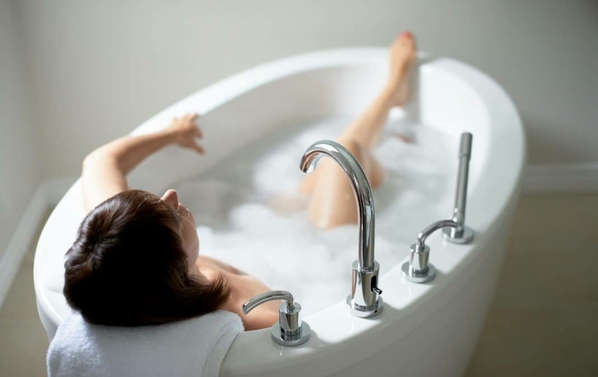Health and Wellness
Is a Hot Bath or Sauna the Same as Exercise?
I study the effects of exercise on the body. So it’s perhaps unsurprising that when I’m not in the lab, I like to keep active by hitting the gym or going for a run. But for many people it’s much harder to get out and move their bodies.
Modern life doesn’t always make it easy to maintain a healthy, active lifestyle.
Yet even for someone like me, exercise isn’t always enjoyable. I have to repeatedly push myself to the point of tiredness and discomfort, in the hope that I will get fitter and stay healthy. Surely the health benefits of a hot bath or a stint in a sauna – a far more attractive proposition – can’t be compared? Yet this is the question I have dedicated myself to answering. And the evidence, thus far, is promising.
The term “exercise is medicine” is rightfully well publicised. It’s one of the best ways to stay healthy, yet medicine doesn’t work if you aren’t prepared to take it. Exercise adherence is very poor, with many people unwilling to exercise due to lack of time and motivation. And for those who are older or have chronic diseases, exercise can also cause pain, which for obvious reasons limits exercise further.
Globally, about 25% of adults don’t meet the minimum recommended physical activity levels of 150 minutes of moderate intensity activity or 75 minutes of vigorous intensity activity per week, or a combination of both. In the UK the figures are even worse, with around 34% of men and 42% of women not achieving these guidelines. Sadly, such high levels of sedentary behaviour are thought to be linked to about 11.6% of UK deaths annually.
In a world where many of us are working nine-to-five office jobs and our daily tasks can be completed by a mere click of a button, it’s easy to see why the modernisation of societies have led to higher levels of sedentary behaviour.
There is an urgent need to find alternative strategies to improve health that people are willing to follow.
In an effort to find such a solution, I’m looking into how hot baths and saunas affect the body. Throughout human history, multiple cultures around the world have used heat therapy to improve health. But until recently, the benefits of bathing were anecdotal and largely viewed as unscientific.
In the last few decades evidence has been growing and today we know that regular bathing in a sauna or hot tub can help reduce the risk of cardiovascular disease – and may well have wider health benefits too.

Iceland is one culture with a rich history of bathing in the country’s hot spring lakes. Doin/Shutterstock.com
Our recent review of the research found that
regular sauna or hot tub bathing can indeed bring about some similar health benefits to that of low to moderate intensity aerobic exercise, such as walking, jogging and cycling.
On first glance, comparing a hot bath or sauna to a jog might seem illogical – after all, the former tends to be seen as relaxing and the latter tiring – but they are more similar than you may think.
The next time you are in a hot tub, bath or sauna, take a moment to listen to your body. You will initially be hit by a pleasant sensation of heat that increases your body temperature and you will start to feel hot and sweaty. This is accompanied by a subtle elevation in heart rate. Starting to sound familiar? Yes – these bodily responses take place during exercise too.
As part of a group of researchers at Coventry University, I’ve compared the similarities and differences between the physiological responses of exercise and heating. In order to do this, I ask volunteers to undergo the same duration of hot tub bathing and moderate intensity cycling. While exercise is more adept at increasing energy expenditure, we have found comparable elevations in core body temperature and heart rate.
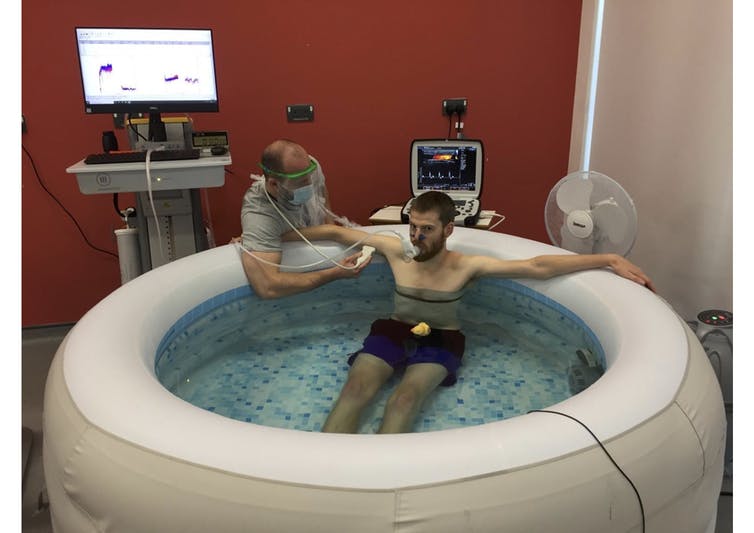
Measuring heart rate, energy expenditure through gas exchange and artery blood flow via ultrasound. © Charles Steward, Author provided
The similarities also go beyond what you can physically feel. By doing ultrasound scans of the arteries, I also observe similar increases in blood flow.
Importantly, away from the lab, long-term observational studies have demonstrated that the
application of heat at rest, or what academics like to call “passive heating”, has the potential to be pleasurable, practical and potent at improving health.
But as the old saying goes, when something sounds too good to be true, it probably is. Before you contemplate cancelling your gym membership and investing the savings in a Jacuzzi, know that regular saunas or baths are unable to replicate all the health benefits of exercise training, such as promoting fat loss and increasing muscle mass.
Using hot baths or saunas shouldn’t be considered as a substitute for exercise.
But it can mimic some of the health benefits – and we think that when used in conjunction with exercise, it can give rise to greater health.
From Japan to Rome
Sitting and sweating in hot bodies of water or hot steamy rooms is an activity that has been at the centre of multiple cultures across the globe for millennia.
The Romans, for example, are famous for their love of hot baths. Bathing in their neighbourhood thermae – the communal baths – were considered a relaxing social activity. Other similar practices have occurred all over the world. These include the likes of onsen (hot spring) bathing, which is a central part of Japanese culture, and jjimjilbang (public bathhouses) that are common in South Korea. In your standard hot tub, such bathing tends to involve being submerged up to your shoulder in hot water at around 38-40°C for anywhere up to 60 minutes.

A man enjoys the hot spring at Nyuto Onsen, Tohoku, Japan. Burin P/Shutterstock.com
Traditional dry saunas are a popular pastime in many Nordic countries, and have been for centuries. Originally fuelled by wood burning fires and more commonly now with electrical heating elements, these are usually heated to 70-110°C with a humidity between 5-20%. Nowadays, higher humidity levels are often achieved by pouring water over heated stones. Heating bouts are normally between 5-30 minutes and are usually separated by a short cold shower, before repeating the process. Incredibly, there are around 3 million saunas in Finland alone, a country of 5.5 million people.
All of these cultures – and the many other historic and current cultures for which bathing is popular – extol the health benefits of these practices. And we now know they have been right all along.
The benefits are not only restricted to physical health: heat therapy can also act as an antidepressant. In this regard, the social aspect of group bathing is likely to be important.
The thought of stripping off one’s clothes and bathing or sweating in close proximity to several strangers may not be everyone’s cup of tea, yet in countries where saunas or hot baths are integrated within daily life, the general public appear to be reaping the benefits.
In the first long-term observational study of its kind, in middle-aged Finnish men, it was found that sauna bathing frequency was associated with a decreased risk of fatal cardiovascular disease. Those who participated in four to seven sauna sessions per week had an astonishing 50% reduction in the risk of fatal cardiovascular disease when compared to those who went once a week. The same study also showed that sauna attendance was associated with a significant decreased in the risk of dementia and Alzeimher’s disease. It’s not such a surprise that the Finns refer to saunas as “the poor man’s pharmacy”.
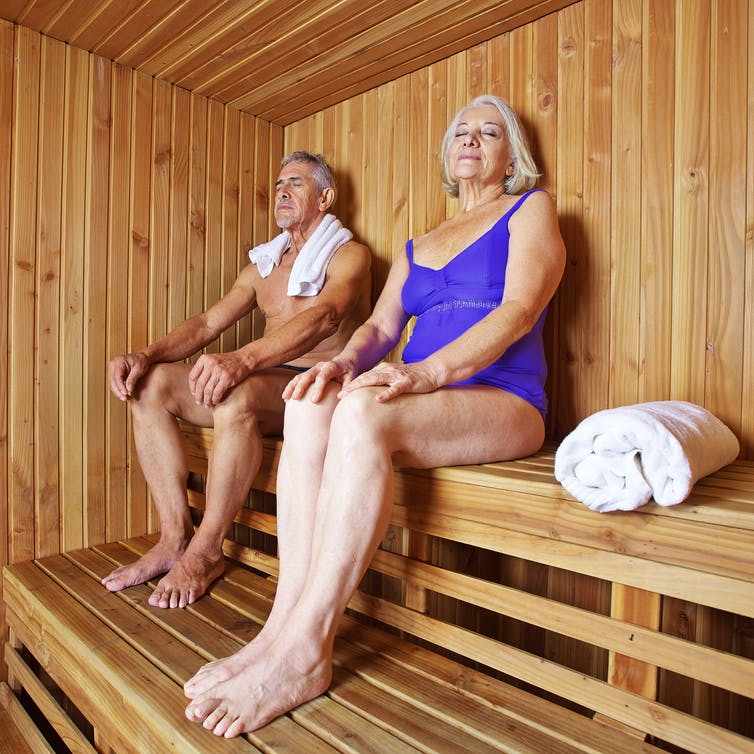
Enjoying the heat in a traditional Finnish sauna. Robert Kneschke/Shutterstock.com
Meanwhile, researchers from Japan have shown that higher frequencies of habitual hot tub bathing have protective effects against fatal and non-fatal cardiovascular events.
While these long-term observational studies illustrate a reduction in the risk of cardiovascular disease through regular heat exposures, it’s worth flagging that they only show a relationship. In other words, we cannot definitively prove whether heat protects us against cardiovascular disease or if it’s some other factor that has positively changed over the years, such as diet or activity levels.
Yet on the basis that cardiovascular disease is primarily caused by diseases of the artery, it’s probable that improvements in blood vessel health – which we now know occurs with regular heat therapy – is a large reason for the reduction in the risk of cardiovascular disease.
Harnessing heat for health
To explore why this is the case, let’s take a deeper look at some of the physiological responses and long-term health benefits that can occur through elevations in body temperature.
When your temperature begins to rise, you must find a way to lose excess heat in order to regulate body temperature. One of the principal mechanisms that facilitates heat dissipation from the body is an increase in blood flow to your skin, which is in part supported by the vasodilation (widening) of your arteries and capillaries. This elevation in blood flow, which I measure through ultrasound scans, also promotes the production of various molecules in the blood that help cell growth, repair and protection of your blood vessels.
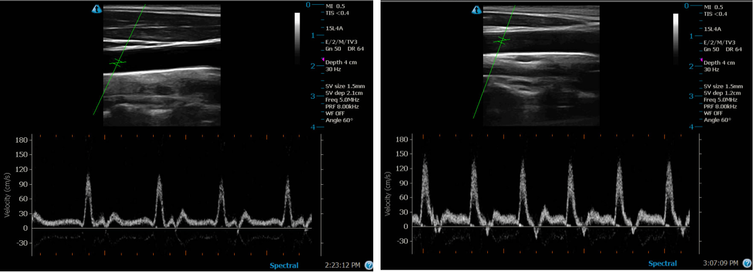
Ultrasound images showing the blood flow velocity in the common carotid artery of the neck before and immediately after hot tub bathing. © Charles Steward, Author provided
Although the basic physiological responses of saunas and hot baths are similar, they are not identical. The biggest difference is that hot baths have the added influence of hydrostatic pressure – the force exerted by the water. This assists in the return of blood to your heart.
Albeit not proven yet, it has been speculated that this could make hot tub therapy advantageous over sauna for improving cardiovascular health.
The earliest lab-based research into the health benefits of heat therapy took place in the late 1990s and early 2000s. One of the first studies revealed that both sauna and hot water bathing, once or twice per day, five times per week, over four weeks, enhanced the function and wall structure of the heart in patients with chronic heart failure.
Other research conducted at a similar time looked at infrared saunas that, contrary to traditional saunas, use radiation to heat you from the inside out at a temperature of 50-60°C, typically without humidity.
In addition to benefits for the heart, it was found that four weeks of sauna use improved blood pressure, exercise tolerance, fitness levels and reduced hospital admissions.
Meanwhile, research into daily hot tub therapy for three weeks was shown to lower blood glucose levels in patients with type 2 diabetes. This is important because having high blood sugar for excessive periods of time can cause serious damage to your blood vessels. Although this early research did have methodological limitations, such as the lack of standardised heating protocols, it has inspired much of today’s work.
More recently, numerous studies guided by Chris Minson at the University of Oregon have started to highlight some of the mechanisms by which hot tub therapy can keep us healthy. In these studies, the core body temperatures of participants were increased by around 1.5°C for 60 minutes by sitting in water at 40.5°C. This was then repeated three to five times per week, over eight to ten weeks.
Following this period, improvements in artery health and blood pressure were observed in sedentary healthy adults and obese women with polycystic ovary syndrome.
The team also reported reductions in a range of factors related to cardiovascular disease risk, such as fasting glucose (levels of circulating blood sugar after an overnight fast), total cholesterol (overall levels of circulating blood fats) and chronic low-grade inflammation (small but long-term rise in immune cells) in patients with polycystic ovary syndrome.
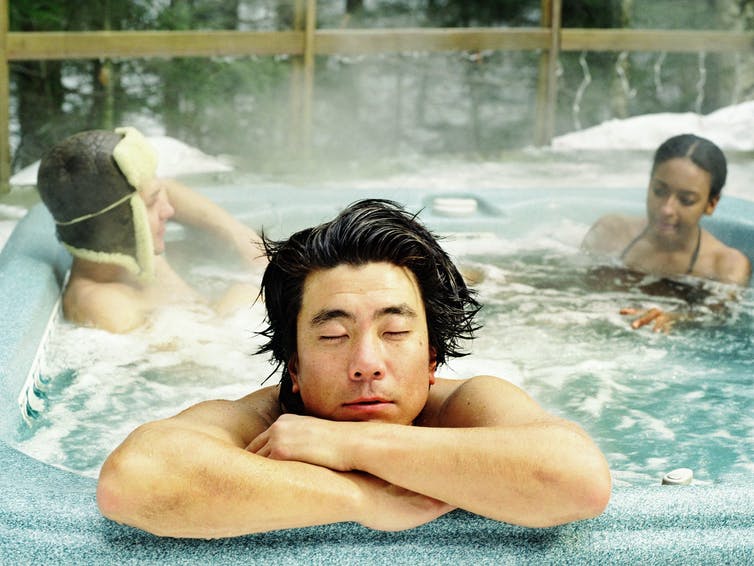
In the hot tub in the winter. Monic Zrivoic/Shutterstock.com
These findings indicate that hot tub therapy can benefit both diseased and healthy populations in a variety of different ways.
How safe is it?
Before you hop in the tub and try to recreate this, I want to point out that the water temperatures and lengths of time mentioned above are not representative of your everyday bath. In your conventional bathtub, the temperature will gradually drop. Accordingly, when using my hot tub in the lab, I must carefully monitor my volunteers for safety reasons: I measure their core body temperature (using a rectal thermometer), blood pressure and constantly check in with how comfortable they are with the heat of the water.
Anyone who has sat in a hot tub or sauna for a bit too long probably already knows why I do this. On standing, heat exposure can lead to dizziness, a loss of balance and increase the risk of fainting. This is caused by a phenomenon called orthostatic hypotension, where a combination of the widening of the blood vessels caused by the heat, and a change in the posture of your body (such as going from sitting to standing), results in a large drop in blood pressure and a decrease in blood flow to your brain. This can, unsurprisingly, be dangerous.
It’s also worth mentioning that you can often become dehydrated as you continuously sweat. This can contribute to feeling what is often described as a “heat hangover”, with an accompanying headache and fatigue, that people may be familiar with. So it’s sensible to always drink plenty of water and if you start feeling light headed, get out of your bath or sauna slowly.
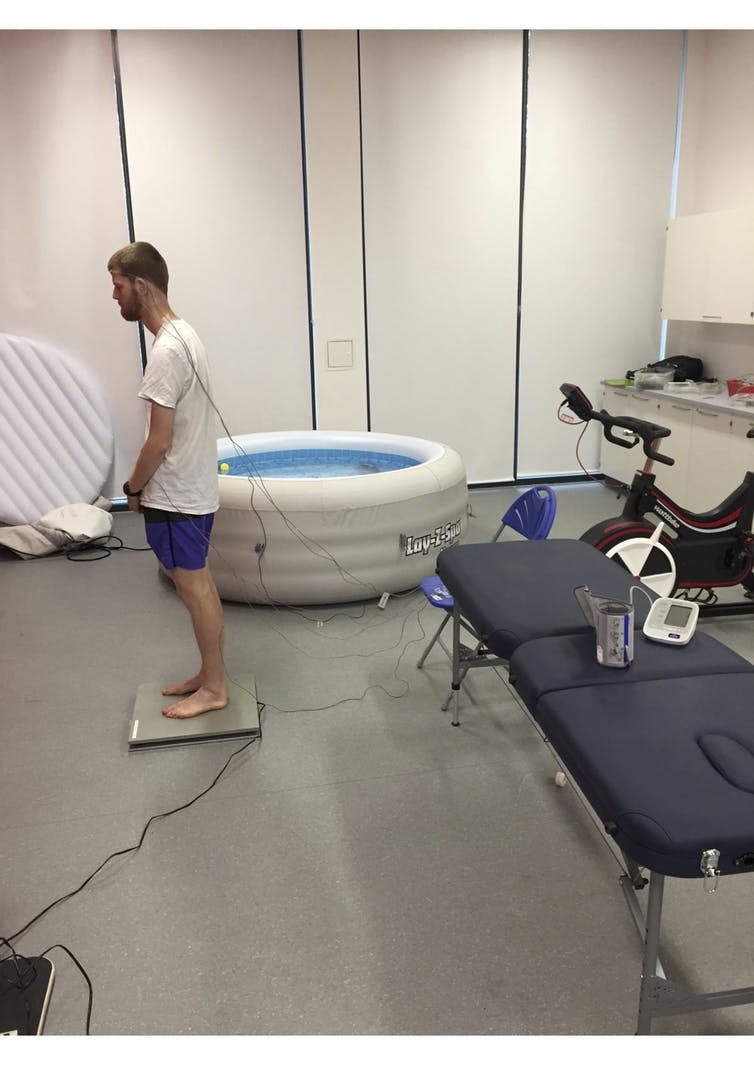
Assessing balance before bathing to compare with balance immediately after. © Charles Steward, Author provided
But the health benefits don’t solely depend on maintaining high core body temperatures. So your run-of-the-mill hot bath might still do the trick. Researchers from Liverpool John Moores University have demonstrated that when core body temperature was only increased by around 0.6°C and repeated three times per week for six weeks, the growth of new blood vessels, increases in insulin sensitivity (more effective use of blood glucose) and improvements in fitness still occured.

You don’t need a sauna or a Jacuzzi to reap the benefits. Ava Sol/Unsplash, FAL
This is thought to be linked to an increase in blood flow to your skin, which is not reliant on attaining a high core temperature. The elevation in blood flow results in an increase in the frictional force between the blood and the inside of your blood vessel walls. This triggers the release of molecules into the bloodstream. When this response is repeated over months, these molecules assist in the formation of new blood vessels and repair damaged ones.
This can help lower blood pressure as well as increase oxygen and glucose delivery to the muscle, which collectively can reduce cardiovascular disease risk and improve fitness.
While we are a far cry from being able to recommend an ideal heat therapy to improve health, it’s possible that only a fortnight of regular hot tub therapy may lower your fasting blood glucose (levels of circulating blood sugar after an overnight fast). Improvements in blood vessel health, meanwhile, seem to require a couple of months.
Heat therapy vs exercise
Although highly dependent on the magnitude of the exercise and heating stimulus, our recent review found that both exercise and heat therapy can promote cardiovascular health by comparable improvements in fitness, blood vessel health, blood pressure and glucose levels. Promisingly, there are also some encouraging signs for similar improvements in cardiac function and wall structure, as well as chronic low-grade inflammation in diseased populations.
Protection against fatal cardiovascular disease is further increased in those who regularly exercise and frequently bathe in contrast to either independently. Meaning that doing both exercise and heating is likely the best option.
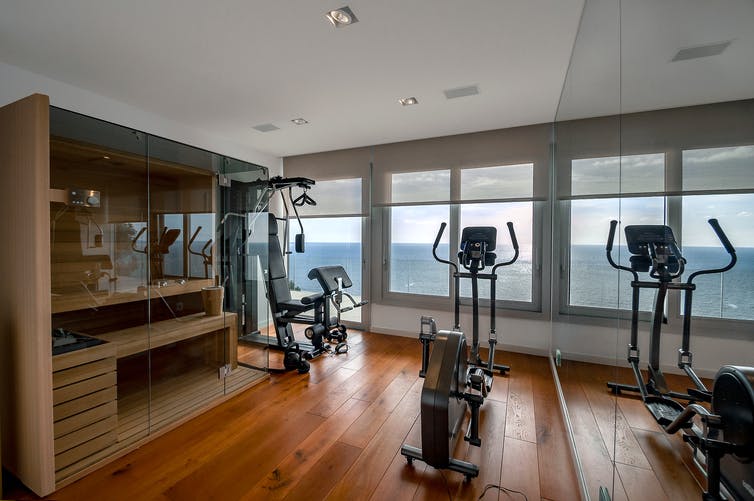
If your local gym has a sauna, combine the exercise and the heat treatment for further benefit. Karnavalfoto/Shutterstock.com
This is partially due to the energy expenditure of a single hot tub session typically being markedly lower than exercise. We know that long term weight management is essentially dependent on expending more energy than you take in, this means that just using saunas or hot tubs is not going to help much if your aim is to lose weight.
On top of this, sitting in a bath or sauna obviously doesn’t require physical movement. As such, your muscles don’t need to contract, and your bones aren’t stressed by the ground reaction forces from walking or running. It is therefore likely that heat is inferior at improving muscle mass and bone density which are really important aspects of health especially as you age.
Personally, I think the most exciting prospect of this research is for people who are unable to exercise, or those who find it very hard to start.
When someone is unable to exercise, heat therapy – whether in hot tubs or saunas – could be viewed as a “gateway therapy” to future exercise participation. This is because heat can increase fitness and functional capacity.
It’s therefore also a promising method for those that suffer pain during exercise due to chronic diseases. A good example is peripheral artery disease, where the arteries in the legs become blocked by fatty deposits. This causes a lack of blood flow to the muscle and severe pain. Because heating increases blood flow, heat can have therapeutic potential here.
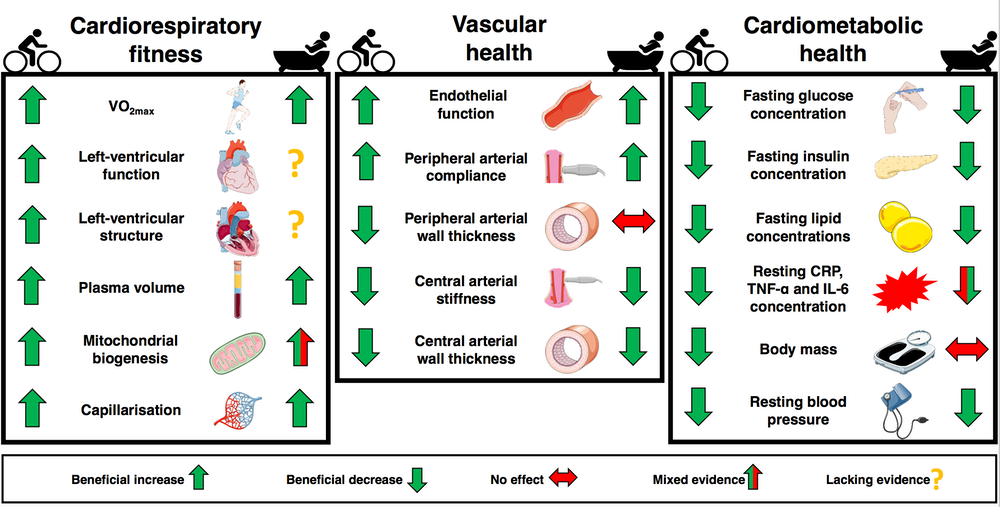
A comparison between exercise and heat treatment. © Charles Steward, Author provided
Hot tub bathing after exercise
Physical inactivity is a major culprit driving the progression of chronic diseases and ultimately premature death worldwide. Many people don’t meet the recommended physical activity guidelines, but on the bright side 20-40% take part in some form of structured exercise or physical activity in their weekly routines. Just not enough. Therefore, maximizing the health benefits from smaller amounts of exercise could be of great value.
I’m currently investigating whether post exercise hot tub bathing can extend and intensify the health benefits of exercise. My pilot data is promising. In the future I will be taking more invasive measurements, such as blood samples, to look into whether heating after exercise can increase the number of circulating molecules that have a role in enhancing blood vessel health. Although my research is still in its early stages, we think it’s probably best to try and maintain the increase in body temperature after exercise in order to optimize health benefits.
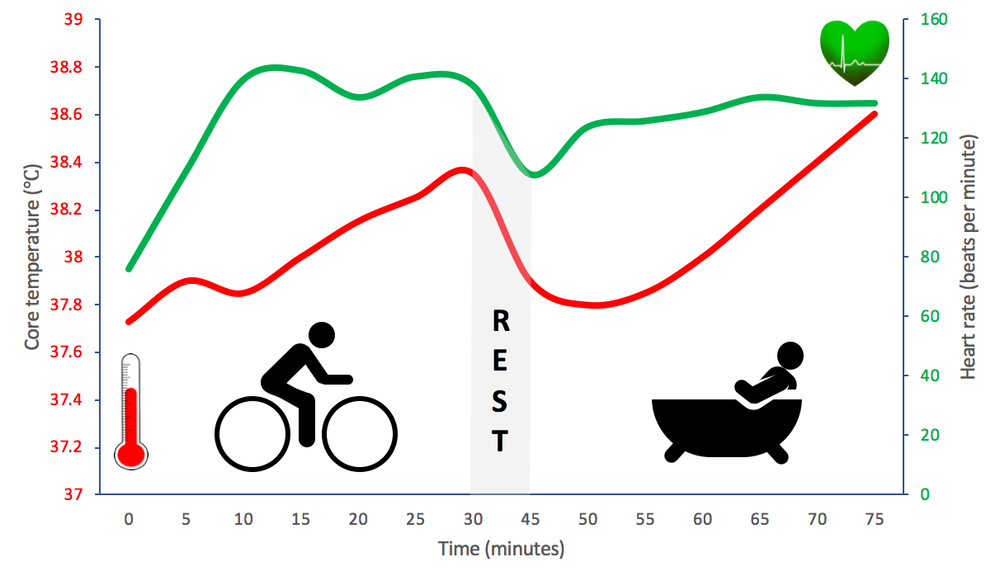
A line graph showing core temperature and heart rate responses to 30 minutes of moderate intensity cycling followed by 30 minutes of hot tub bathing (40°C), separated by a 15 minute rest period. © Charles Steward, Author provided
So, if jumping into a hot bath after exercise can bring about greater health benefits, post-exercise heating would also be an attractive option for anyone who isn’t quite active enough.
The future of heat research
Research into the health benefits of heat is in its infancy. More long-term clinical trials in a range of healthy and diseased populations are needed before we can start to fully understand how to harness its full potential. This will enable us to start establishing the most effective temperatures, durations, frequencies and types of heating to improve specific health pointers for particular groups of people.
To date, a large number of heating studies have pushed participants to the point of thermal discomfort to promote health. Reaching such high temperatures for long lengths of time are challenging to tolerate and impractical in real-world scenarios. Given that long-term adherence will underpin any lasting health benefits, finding heat therapies that are practical, tolerable and capable of improving health will be key. Directing research towards more convenient and enjoyable types of heating will ensure better uptake. And once all of this work has been done, I hope that healthcare practitioners may one day recommend the use of heat independently and alongside exercise to enhance health.
So, while exercise remains the best way to improve your health, research shows that bathing in a sauna or hot tub are alternative options for those who are either unwilling or unable to take part in enough exercise.
I will certainly continue to jump in my bath after the gym – and on my days off. Why not dip a toe in?
This article is republished from The Conversation under a Creative Commons license. Read the original article.




